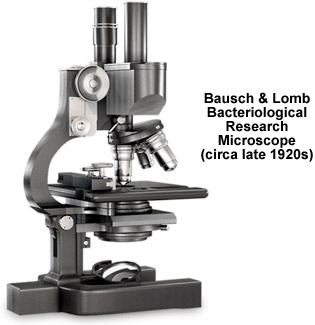Bausch & Lomb Bacteriological Research Microscope
Microbiologists in the early twentieth century often favored the Bausch & Lomb model CBE binocular microscope, because the instrument was designed and specially equipped to assist in bacteriological research. The model featured below was redrawn from photographs of the original microscope, which is part of the Bausch & Lomb microscope collection published in early instrument manuals and catalogs.

Equipped with dual oculars, the microscope is designed to provide relief from eyestrain during prolonged periods of observation and to compensate for the limited depth perception afforded by stereoscopic-like viewing. The addition of a mechanical stage enhances utilization of the instrument as a tool in routine and higher-level bacteriological investigations. Microscopists can smoothly translate specimen slides in both the x- and y-directions by turning a rack and pinion mechanism while simultaneously viewing the object. The large square stage also features measuring scales ruled in single millimeters accompanied by verniers. Objectives are easily interchangeable and can be secured three at a time to a revolving nosepiece.
Standard accessories include a readily adaptable monocular and drawing tube, which allows the instrument to be used to project, draw, and photograph specimens. Illumination is achieved through a substage mirror by use of an external light source. Light is passed through a standard substage condenser where it forms a cone of illumination employed to view the specimen. A swivel joint adjoining the limb to the horseshoe base allows the microscopist to adjust the instrument for comfortable viewing. Focus is achieved by a rack mechanism that translates the body tube while holding the specimen stationary on the stage.
BACK TO TWENTIETH CENTURY BAUSCH & LOMB MICROSCOPES
BACK TO TWENTIETH CENTURY MICROSCOPES
